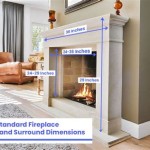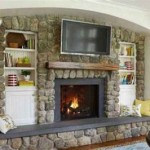```html
Victorian Style Fireplace Tiles: A Timeless Elegance
Victorian style fireplace tiles represent a significant aspect of interior design during the Victorian era (roughly 1837-1901). This period, marked by Queen Victoria’s reign in Britain, witnessed a burgeoning middle class, advancements in manufacturing, and a fascination with ornamentation and detail. Fireplaces, traditionally a necessity for heating, evolved into prominent architectural features, becoming focal points within homes. The tiles adorning these fireplaces transformed from purely functional cladding into elaborate works of art, reflecting the opulence and sentimentality characteristic of the Victorian aesthetic.
The popularity of Victorian fireplace tiles stemmed from several factors. The Industrial Revolution facilitated mass production of tiles, making them more accessible and affordable to a wider segment of the population. Concurrently, technological advancements in tile manufacturing enabled the creation of more intricate designs and vibrant colors. The Victorian era also embraced eclecticism, drawing inspiration from various historical styles, including Gothic Revival, Renaissance Revival, and Aesthetic Movement. This diversity is reflected in the wide range of patterns and motifs found in Victorian fireplace tiles.
Materials used for Victorian fireplace tiles were varied, though ceramic tiles, particularly those made from earthenware and later, porcelain, were the most common. Earthenware provided a suitable base for intricate designs and a wide range of glazes, offering a relatively inexpensive option. Porcelain tiles, though more costly, offered superior durability and resistance to heat, making them a desirable choice for fireplaces that were frequently used. Other materials, such as encaustic tiles (tiles with inlaid patterns) and occasionally marble, were also incorporated to add a touch of luxury and sophistication.
Common Motifs and Designs
Victorian fireplace tiles are characterized by a rich tapestry of motifs and designs. Floral patterns were exceedingly popular, reflecting the Victorian era's love for nature and sentimentality. Roses, lilies, daisies, and other flowers were frequently depicted in realistic or stylized forms, often accompanied by foliage and intricate borders. These floral motifs symbolized love, beauty, and domestic tranquility, appealing to the Victorian sensibility.
Animal motifs were also prevalent, featuring birds, butterflies, and mythical creatures. Birds, such as swallows and robins, were often associated with home and hearth, while butterflies symbolized transformation and beauty. Mythical creatures, such as griffons and dragons, added a touch of exoticism and historical grandeur, aligning with the Victorian penchant for eclecticism.
Geometric patterns were also widely used, particularly in borders and more formal designs. These patterns could range from simple repeating shapes to complex interlocking designs, often incorporating elements from different historical styles. Geometric patterns provided a sense of order and structure, complementing the more ornate floral and animal motifs.
Besides these broad categories, many Victorian fireplace tiles featured narrative scenes, depicting historical events, literary themes, or everyday life. These narrative tiles added a personal touch to the fireplace, reflecting the homeowner's interests and values. They often served as conversation starters, fostering a sense of community and shared experiences.
Color Palettes and Glazes
The color palettes used in Victorian fireplace tiles were often rich and vibrant, reflecting the Victorian era's preference for bold and dramatic hues. Deep reds, greens, blues, and browns were commonly used, often combined with metallic accents, such as gold and silver, to add a touch of opulence. The use of contrasting colors was a common technique to highlight intricate details and create visual interest.
Glazes played a crucial role in enhancing the appearance and durability of Victorian fireplace tiles. Lead glazes were commonly used to create a smooth, glossy surface that was resistant to staining and moisture. However, the use of lead glazes posed health concerns, leading to the development of alternative glazes in later years. Enamel glazes, which involved applying a vitreous coating to the tile surface, allowed for a wide range of colors and decorative effects.
Lustre glazes, which imparted a metallic sheen to the tile surface, were particularly popular for adding a touch of luxury and sophistication. These glazes were achieved by firing the tiles in a reducing atmosphere, which created a thin layer of metallic oxide on the surface. The iridescent effect of lustre glazes added a unique and eye-catching element to Victorian fireplace tiles.
The specific color palettes and glazes used often varied depending on the manufacturer and the intended style of the fireplace. Some manufacturers specialized in particular color combinations or glazing techniques, creating distinctive styles that were highly sought after by consumers.
Manufacturers and Regional Styles
Numerous manufacturers produced Victorian fireplace tiles, each with its own distinctive style and product range. Prominent manufacturers in Britain included Minton, Maw & Co., and Craven Dunnill & Co. These companies employed skilled designers and craftsmen to create high-quality tiles that were widely distributed throughout the country and exported to other parts of the world. Continental European manufacturers, such as Villeroy & Boch in Germany, also produced significant quantities of Victorian style fireplace tiles.
Minton was renowned for its encaustic tiles and intricate designs, often incorporating elements from Gothic Revival and Renaissance Revival styles. Maw & Co. specialized in geometric patterns and durable tiles suitable for both residential and commercial applications. Craven Dunnill & Co. was known for its innovative glazing techniques and wide range of colors and decorative effects.
Regional styles also emerged, reflecting the specific tastes and preferences of different areas. For example, tiles produced in the Arts and Crafts movement often featured simpler designs and naturalistic motifs, emphasizing handcrafted quality and local materials. Tiles produced in Scotland often incorporated Celtic knotwork and other traditional Scottish designs.
Identifying the manufacturer and regional style of a Victorian fireplace tile can provide valuable insights into its history and artistic significance. Marks and stamps on the back of the tiles often indicate the manufacturer, date of production, and origin. Studying surviving catalogs and design books can also help to identify the specific style and patterns produced by different manufacturers.
The intricate detail, vibrant colors, and diverse designs of Victorian fireplace tiles contribute significantly to the aesthetic appeal of Victorian interiors. Understanding the history, materials, motifs, and manufacturing processes involved in their creation allows for a deeper appreciation of these captivating artifacts and their enduring legacy in the world of interior design.
```
Peacock Victorian Fireplace Clay Squared To Infinity

30 Living Space Styles With Fireplaces Victorian Fireplace Tiles Floor

Victorian Cream Glazed Tile 4075 Fireplace

Highlighted Tiled Fireplace And Flat Victorian Marble Cast Fireplaces

Victorian Style Fireplace Tiles Set Ref Vic 2 Pilgrim

36 Awesome Victorian Fireplace Tiles S Tile

Victorian Burgundy Glazed Tile 4371 Fireplace

Victorian Fl Fireplace Tiles Set Ref Vic 01 Pilgrim

Sunset And Herons Tile Victorian Style Fireplace Tiles

Ceramic Fireplace Tiles Victorian Firetile Ltd
Related Posts








